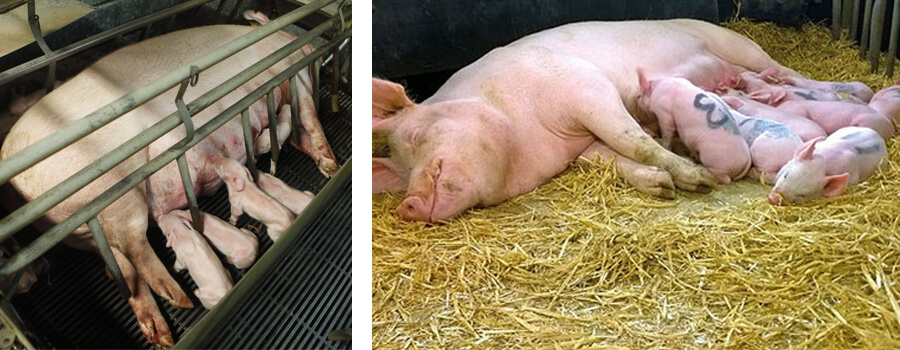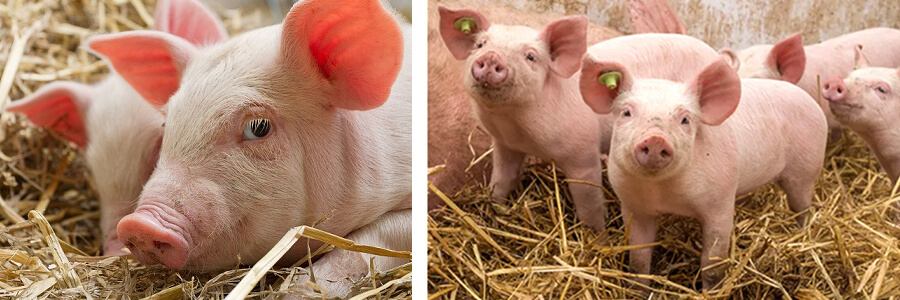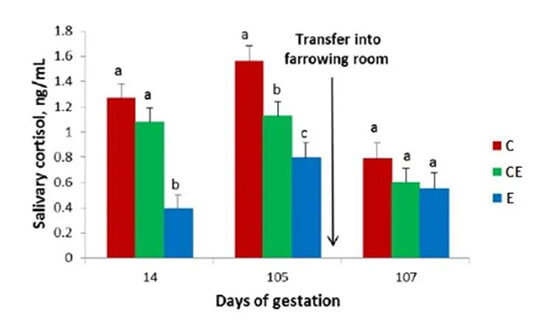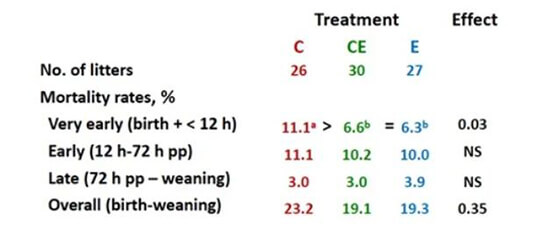Enriching sow environment and diet improves sow welfare and early piglet survival



Figure 1. Enrichment reduced salivary cortisol concentrations
| New research shows environmental stress during gestation can influence piglet health and mortality after birth. Furthermore, it shows that enriching the sow environment and diet in conventional systems can meaningfully improve sow welfare, piglet survival and performance. [1] The research, conducted by the French National Institute for Agricultural Research (INRA) with funding from PROHEALTH, builds on previous work looking at the effects of gestational housing systems on maternal stress, piglet maturity and early survival. Compared to conventional systems with slatted floors, the earlier work found that enriched systems with straw bedding and more space per sow were associated with lower stress levels and piglet mortality, and improved maturity at birth. [2] |

| "It's not always possible to rebuild all farms according to most welfare-friendly standards, but it is possible to enrich conventional systems in a way that demonstrably improves welfare and performance." According to Hélène Quesnel, PhD, the lead investigator of both studies, the new research sought to confirm the results of the first study, while evaluating the impact of adding enrichment material to conventional gestational housing systems. "The link between maternal stress and piglet survival is well documented, and it is also widely accepted that conventional systems are more stressful than enriched ones," Quesnel said. "However, we recognise that it isn't always possible for farmers to meet the space and environmental requirements of the enriched systems, so we sought to find a middle ground by enriching conventional facilities." |

| Study design The study aimed to investigate a strategy of environmental and nutritional enrichment to reduce maternal stress and its consequences on piglet mortality. Gestating sows were group-housed in a conventional system on a slatted floor (C, n = 26), in the same conventional system with environmental and nutritional enrichment (CE, n = 30) or in larger pens enriched with straw bedding (E, n = 27). The enrichment of the CE group consisted of pieces of oak attached to a chain (three per pen) and straw pellets provided in the trough at a rate of 200 g/day from 3-30 days of gestation (DG) and 400 g/day from 31-104 DG. On DG 105, sows were transferred into farrowing pens and housed in identical individual stalls on a slatted floor. Researchers measured cortisol concentration — an important indicator of stress — during gestation. They also recorded sow behavioural and investigative activities as well as piglet mortality. Results Results indicate that maternal stress and mortality were inversely correlated with the level of enrichment. Cortisol concentration was greater (P < 0.05) in the C and CE sows than in E sows on DG 14. On DG 105, it was intermediate in CE sows compared with C and E sows (before transfer to farrowing pens), and no longer differed among the 3 treatments on DG 107, after the transfer (Figure 1). |

Figure 1. Enrichment reduced salivary cortisol concentrations
|
Sow behaviours related to boredom or frustration — known as stereotypies — also decreased with the level of enrichment. On DG 101, CE sows exhibited a lower proportion of stereotypies compared to C sows (22 vs. 34%, P < 0.05) but a greater proportion compared to E sows (7%, P < 0.05). On this same day, CE sows had more investigative sequences than C sows (7.3 ± 7.0 vs. 1.7 ± 1.8, P < 0.01) but less than E sows (20.3 ± 13.8; P < 0.01).
Early mortality (i.e., piglets dead at birth + piglets that died within 12 hours of birth) was lower in groups CE and E (6.6% and 6.3%, respectively) than in group C (11.1%, P < 0.05), but overall mortality (stillbirth + preweaning death) did not differ significantly among the 3 groups (23.2, 19.1 and 19.3% in groups C, CE, and E, respectively, P = 0.35) (Figure 2). |

Figure 2. Enrichment reduced very early piglet mortality
| Improving welfare to improve performance Based on these findings, the researchers concluded that enriching the sow diet with straw and their environment with manipulable objects helps improve sow welfare, which in turn helps reduce early piglet mortality. "We urge farmers to consider sow welfare during gestation to improve piglet survival," Quesnel said. "Housing systems for gestating sows should provide enrichment that can reduce sow stress, such as straw pellets, rope and pieces of wood." She added, "It's not always possible to rebuild all farms according to most welfare-friendly standards, but it is possible to enrich conventional systems in a way that demonstrably improves welfare and performance." [1] Quesnel et al. “Enriching the sow environment and diet during gestation reduced piglet neonatal mortality.” Book of Abstracts, 69th Annual Meeting of the EAAP, Aug 2018, Dubrovnik, Croatia, p. 404. [2] Quesnel et al. “Effects of gestation housing systems on maternal stress, piglet maturity at birth and early survival.” Annual Meeting of the EAAP, Aug 2016, Belfast, United Kingdom. Wageningen Academic Publishers, 22, 2016, Annual Meeting of the European Association for Animal Production. Original from: https://thepigsite.com/articles/enriching-sow-environment-and-diet-improves-sow-welfare-early-piglet-survival by 5m Editor |







